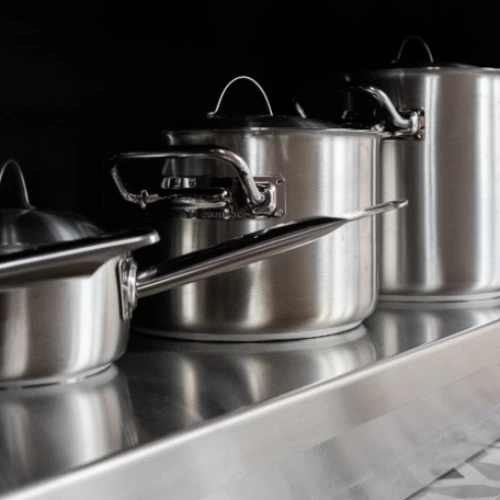The “Kitchen Drama” of Stainless Steel Woks: From Iron to 304 - Who’s “Poisoning” Your Kitchen?
In the bustling world of kitchens, the humble wok has long been a staple for cooking up delicious stir - fries, searing meats, and simmering sauces. But with the rise of different materials, from traditional iron to modern 304 stainless steel, a “kitchen drama” has unfolded. Are these materials silently “poisoning” our kitchens, or are they safe and reliable cooking companions? Let's dig deeper.

1. The Iron Wok: A Time - Tested Favorite with Hidden Dangers?
Iron woks have been used for centuries, especially in Asian cuisines. They are known for their excellent heat retention and distribution. When heated, an iron wok can quickly reach high temperatures, perfect for that quick - fire stir - frying that locks in the flavors of the ingredients.
However, iron woks have their drawbacks. One of the main concerns is rust. Iron is highly reactive with oxygen and moisture. If an iron wok is not properly dried and seasoned after use, it can rust in no time. Rust not only degrades the appearance of the wok but also, in large amounts, can be a potential health risk. Small amounts of rust are generally not harmful as iron is a necessary nutrient for the human body. But if the rust layer is thick and flakes off into the food during cooking, it can affect the taste and potentially cause digestive issues.
Another issue with iron woks is their reactivity with acidic foods. Tomatoes, vinegar, and citrus fruits, for example, can cause the iron to leach into the food. While a bit of iron in the diet can be beneficial, especially for those with iron - deficiency anemia, excessive iron intake can be harmful. High levels of iron in the body can lead to oxidative stress, which may contribute to various health problems such as liver damage, heart disease, and diabetes.
2. Enter 304 Stainless Steel: The New Kid on the Block
304 stainless steel has emerged as a popular alternative to iron in the world of woks. It contains 18% chromium and 8% nickel, which gives it some unique properties.
Durability and Corrosion Resistance
The chromium in 304 stainless steel forms a thin, invisible oxide layer on the surface when exposed to air. This layer acts as a protective shield, preventing the steel from rusting. It can withstand the test of time, even in a humid kitchen environment. Unlike iron woks that may need to be replaced every few years due to rust damage, a 304 stainless - steel wok can last for decades with proper care.
Non - Reactivity
304 stainless steel is non - reactive, which means it won't interact with acidic or alkaline foods. Whether you're cooking a tangy tomato - based sauce or a dish with lots of vinegar, you don't have to worry about the wok leaching unwanted metals into your food. This non - reactivity also ensures that the natural flavors of the ingredients remain intact, without any metallic taste interfering.
Safety Concerns?
Some people may worry about the nickel content in 304 stainless steel. Nickel is a known allergen for some individuals. However, in a well - made 304 stainless - steel wok, the nickel is bound within the alloy structure and does not leach into food under normal cooking conditions. As long as the wok is of good quality and not damaged (such as having deep scratches or dents that could expose the inner layers), the risk of nickel exposure is extremely low.
3. Comparing Performance in the Kitchen
Heat Conduction
Iron woks are great at retaining heat, but they can be a bit slow to heat up evenly. You may find hotspots in the wok, which can lead to unevenly cooked food. On the other hand, 304 stainless - steel woks have a more even heat distribution. They may not retain heat as well as iron woks, but they heat up quickly and consistently, allowing for more precise cooking. For example, when stir - frying vegetables, a 304 stainless - steel wok can ensure that each piece is cooked evenly without some parts being overcooked and others undercooked.
Ease of Cleaning
Cleaning an iron wok requires some effort. After cooking, it needs to be washed promptly, dried thoroughly, and then re - seasoned to prevent rust. Any leftover food residue can also be a breeding ground for bacteria if not cleaned properly. In contrast, 304 stainless - steel woks are a breeze to clean. Their smooth surface doesn't allow food to stick easily, and a simple wash with soap and water is usually enough to get it sparkling clean. Even if there are stubborn stains, a non - abrasive cleaner can quickly take care of them.
4. Making the Right Choice for Your Kitchen
When choosing between an iron wok and a 304 stainless - steel wok, several factors come into play. If you prefer the traditional feel and the extra iron in your diet, and you're willing to put in the effort to maintain an iron wok, it can be a great choice. But if safety, durability, and ease of use are your top priorities, a 304 stainless - steel wok is likely the better option.
In conclusion, neither the iron wok nor the 304 stainless - steel wok is “poisoning” your kitchen. However, understanding their characteristics and potential risks can help you make an informed decision. So, whether you're a seasoned chef or a home cook just starting out, choose the wok that best suits your needs and cooking style, and let the culinary adventures continue without any worries about hidden dangers.